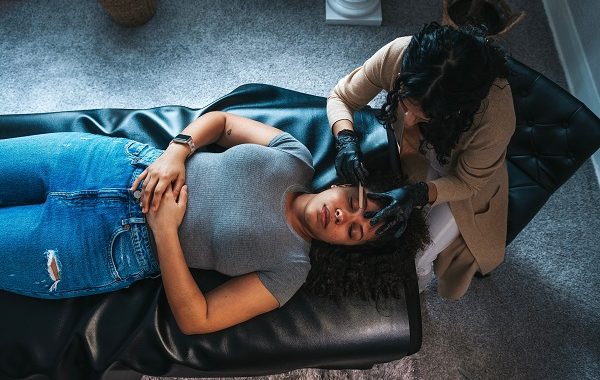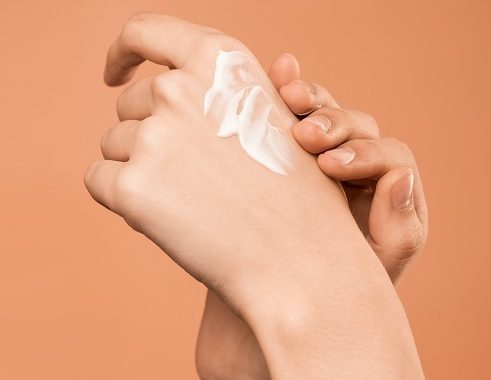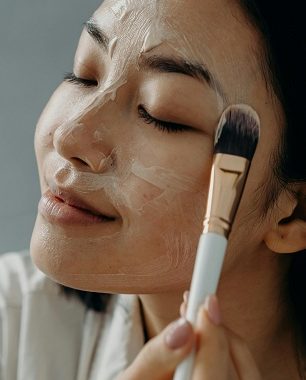
Dermaplaning is a cutting-edge cosmetic treatment designed to rejuvenate your skin by scraping off dead cells and peach fuzz. Administered by trained professionals like plastic surgeons, dermatologists, or cosmetologists, this procedure differs from shaving in tools, amount of skin removed, and the expertise of the practitioner.
Dermaplaning vs. Dermabrasion
While both procedures aim to enhance skin appearance, dermaplaning is less invasive than dermabrasion. Dermabrasion involves abrasion or sanding of the skin and is suitable for more significant skin concerns like acne scars or tattoos. Dermaplaning, on the other hand, is ideal for removing fine facial hairs and is less likely to cause scarring, making it a preferable option for delicate or darker skin tones.
Dermaplaning vs. Shaving
Dermaplaning and shaving both eliminate unwanted hair, but dermaplaning offers an additional benefit – exfoliating the skin by removing dead cells. Shaving only cuts hair at the skin level, while dermaplaning contributes to a smoother complexion by addressing both hair removal and skin rejuvenation.
Benefits of Dermaplaning
The cosmetic benefits of dermaplaning are vast and may include:
- Brighter, more youthful skin tone
- Removal of small hairs or peach fuzz
- Reduction in fine lines and wrinkles
- Smoother skin texture
- Easing hyperpigmentation
- Evening out skin tone
- Clearing pores to limit breakouts
- Reducing deep scars from acne or pox
Dermaplaning Side Effects
While most people experience minimal side effects, short-term reactions may include redness, swelling, soreness, or a tingling sensation for about 48 hours post-procedure. Dispelling a common myth, hair doesn’t grow back thicker or darker after dermaplaning; it may feel coarser initially but softens over time.
Who Should Avoid Dermaplaning?
Dermaplaning is not recommended for individuals with inflammatory skin conditions such as acne, rosacea, psoriasis, eczema, or sunburn. If you’re taking isotretinoin for severe acne, wait six months after discontinuing it before considering dermaplaning.
Dermaplaning how often
Developing a consistent dermaplaning schedule is crucial for optimal results, as individual needs vary. Collaboration with a dermatologist is essential to create a personalized plan aligned with specific skin requirements. The recommended frequency for dermaplaning is generally once a month, a timeline designed to coincide with the natural turnover of skin cells. This monthly session effectively removes old cells, promoting the emergence of new, healthy skin.
However, deviations from this standard may be advised based on the unique needs of the patient. Dermatologists may suggest more or less frequent dermaplaning sessions, tailoring the approach to address individual skin concerns. Post-treatment, close monitoring by the dermatologist is imperative to evaluate how long the results last and make adjustments to the treatment plan accordingly.
Consistency in dermaplaning sessions is emphasized by experts like Ms. Burns, underlining its significance in achieving and sustaining optimal effects. Additionally, a comprehensive skincare routine at home is recommended to enhance the efficacy of dermaplaning and prolong the duration of results. This holistic approach ensures that patients not only adhere to a regular dermaplaning schedule but also actively contribute to maintaining the benefits through proper skincare practices.
Breakouts After Dermaplaning
Results vary depending on skin type, but incorrect techniques or tools during dermaplaning may cause breakouts. If you have active acne or a breakout, it’s advisable to postpone dermaplaning to prevent bacteria spread.
Where to Get Dermaplaning Done
For a safe and effective dermaplaning experience, it’s best to consult a licensed aesthetician or doctor. While DIY kits are available, the risk of injury or infection from using a sharp blade without professional expertise makes professional services a wiser choice.
How to Prepare for Dermaplaning
Before the procedure, discussions with your healthcare provider will include setting goals, assessing skin health, and explaining the dermaplaning process. Avoid exfoliating three days before, and minimize direct sunlight or tanning to prepare adequately.
Dermaplaning tool
The outpatient, noninvasive dermaplaning procedure involves a gentle scalpel gliding along the skin at a 45-degree angle to exfoliate and remove hair. The session’s length depends on the covered area, typically taking 30 minutes to an hour and a half.
Skin Care After Dermaplaning
Post-dermaplaning care involves gentle skincare to maintain results. Recommendations include avoiding harsh products, applying soothing moisturizer and sunscreen daily, and steering clear of direct sunlight and heavy makeup. No downtime is necessary, but using sunscreen and moisturizer is crucial due to increased skin sensitivity.
Dermaplaning at Home: A Cautionary Note
Dermaplaning should only be performed by trained professionals. While at-home kits are available, using them without proper expertise increases the risk of side effects, including scarring. Seek a licensed practitioner for optimal safety and results.
Dermaplaning Regret: The common ones
Engaging in at-home dermaplaning without proper knowledge and training can lead to regrettable consequences, as highlighted by various experts and experiences.
The first regret
The first regret emphasizes the importance of seeking a certified dermaplaning technician to perform the treatment. Certified professionals are trained in proper techniques, ensuring the correct use of tools and minimizing the risk of injury, adverse reactions, or damage to delicate facial skin. Without this expertise, individuals may inadvertently cause infections, irritations, scratches, or scarring. YouTuber Natalies Outlet shares a personal negative experience, cautioning against using old blades without proper knowledge.
The second regret
The second regret delves into the potential worsening of breakouts due to the sliding motion of dermaplaning spreading bacteria. Individuals with acne, active breakouts, or those using acne treatments like Accutane or Isotretinoin are advised to avoid dermaplaning. If attempted, professional guidance is crucial to avoid aggravating existing skin conditions.
Regret #3
Regret #3 addresses the possibility of skin irritation after dermaplaning, emphasizing the importance of consulting with a professional or dermatologist beforehand. For those with occasional sensitivity, an oil planning treatment is suggested to reduce friction during the procedure. The key is to approach dermaplaning with a slow, careful, and light technique to prevent post-treatment discomfort.
Dermaplaning Regret #4
Dermaplaning Regret #4 warns against the reactivation of old cold sores due to improper dermaplaning. Consulting a doctor for oral anti-herpes medication or antibiotics is recommended to prevent outbreaks, and disclosing cold sore history to a skin specialist is essential for safe treatment.
The fifth regret
The fifth regret underscores the necessity of a post-dermaplaning skincare routine. Removing a layer of older skin to reveal a new one requires a restorative approach in the weeks following treatment. Following expert advice, a skincare routine should replenish the skin barrier to ensure long-term smooth and healthy skin. This comprehensive understanding of potential regrets serves as a guide for individuals considering dermaplaning, emphasizing the significance of professional guidance, cautious practices, and diligent post-treatment care.
Conclusion
Dermaplaning emerges as a noninvasive, low-risk procedure for skin exfoliation and hair removal. To maximize results, entrust this procedure to a licensed professional with expertise in dermaplaning techniques. If your skin concerns persist, consult a dermatologist for personalized advice on maintaining healthy, radiant skin.
Further Reading:
Dermaplaning: What It Is, Benefits & Side Effects
Dermaplaning: Efficacy, Side Effects, and More
FAQs
Is dermaplaning good for your skin?
Dermaplaning is beneficial for those without severe skin issues, offering improvements in skin tone, complexion, and removal of unwanted facial hair.
What are the negatives to dermaplaning?
Potential risks include breakouts, cuts, and scarring. Costs range from $100-$300, and results may take a few months, varying based on service quality and skin type.
What happens when hair grows back after dermaplaning?
Hair growth doesn’t typically become thicker or darker after dermaplaning, but its angle may change. The procedure doesn’t provide permanent hair removal, requiring ongoing treatments for sustained results.
Is dermaplaning the same as shaving?
No, dermaplaning is not the same as shaving. While both techniques involve removing unwanted facial hair, dermaplaning is a cosmetic procedure performed by professionals using a scalpel to scrape off dead skin cells and peach fuzz, providing skin exfoliation benefits beyond hair removal. In contrast, shaving simply cuts hair at the skin’s surface and does not involve the same level of exfoliation or skin rejuvenation.
Is dermaplaning good for your hair?
Dermaplaning is not intended for hair on the scalp and is specifically designed for facial hair removal. The procedure involves using a scalpel to scrape off dead skin cells and peach fuzz on the face, contributing to smoother skin and a more even complexion. It is not recommended or suitable for use on the hair on the scalp, as its primary benefits are focused on facial skin exfoliation and improvement rather than hair care.
Where is dermaplaning near me?
To find dermaplaning services near you, consider searching online directories, beauty salons, or dermatology clinics in your local area. Many licensed estheticians and dermatologists offer dermaplaning treatments. Check reviews, ask for recommendations, and ensure the professionals are certified and trained in proper techniques. Additionally, you can inquire at spas or skincare centers for information on dermaplaning services available in your vicinity. Always prioritize certified professionals to ensure a safe and effective dermaplaning experience.
What changes can I expect to see in dermaplaning before and after the treatment?
Dermaplaning typically results in several noticeable improvements in skin texture and appearance. Before the treatment, you may have concerns such as peach fuzz, dead skin cells, and a dull complexion. After dermaplaning, these issues are addressed, and you can expect smoother, softer skin with a more radiant glow. The removal of vellus hair (peach fuzz) can make makeup application smoother, and your skin may appear more even-toned. Additionally, dermaplaning can enhance the effectiveness of skincare products by allowing them to penetrate more deeply into the skin, promoting a healthier and revitalized complexion. It’s essential to follow post-treatment skincare recommendations to maximize and maintain the benefits of dermaplaning.
What is dermaplaning protocol or dermaplane protocol?
Dermaplaning is a non-invasive cosmetic procedure that involves using a sterile surgical scalpel to gently scrape the surface of the skin, removing dead skin cells and fine vellus hair (peach fuzz). This protocol is also known as a dermaplane facial protocol, dermaplaning facial protocol, skin script dermaplane protocol, dermaplaning treatment protocol or dermaplane pro protocol. This procedure is typically performed by skincare professionals or dermatologists and aims to exfoliate the skin, improve its texture, and enhance the absorption of skincare products. The dermaplaning protocol involves cleansing the skin, applying a specialized solution to prep the skin, and then using precise strokes with the scalpel to exfoliate. The result is often smoother, brighter skin with a more even tone. However, it’s essential to follow proper hygiene and safety measures during dermaplaning to minimize potential risks.
What is dermaplaning protocol pdf?
While specific dermaplaning protocols may vary, a dermaplaning protocol in PDF format typically outlines the step-by-step procedure for performing dermaplaning. It may include instructions on prepping the skin, sterilizing equipment, the actual dermaplaning technique, and post-procedure care. This digital document serves as a comprehensive guide for skincare professionals, aestheticians, or dermatologists, offering a convenient and accessible resource for ensuring a standardized and safe dermaplaning procedure. The PDF format allows for easy sharing, referencing, and printing for use in a clinical or spa setting. Sometimes it called dermaplaning protocolo pdf.



Pingback: Dermaplaning side effects - Acnes derma relief
Pingback: 10 Surprising Dermaplaning Benefits You Didnot Know About - Acnes derma relief
Pingback: Art of Dermaplaning at Home - Acnes derma relief
Pingback: Best professional dermaplaning tool - Acnes derma relief
Pingback: How Often Dermaplane? - Acnes derma relief
Pingback: Navigating Dermaplaning Regret - Acnes derma relief
Pingback: Is dermaplaning good for your skin - Acnes derma relief